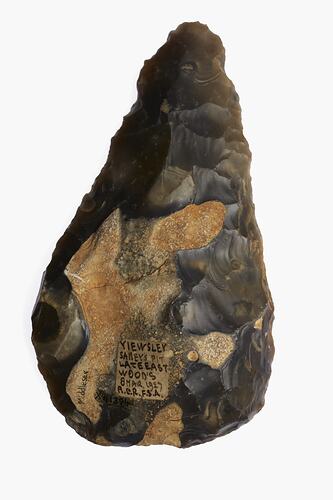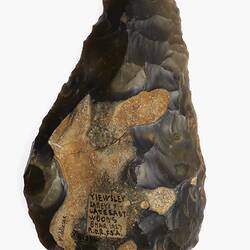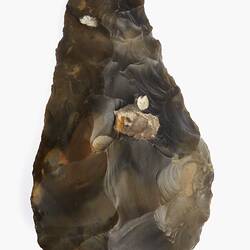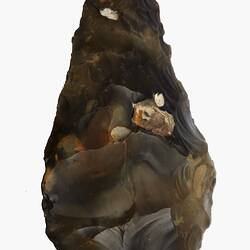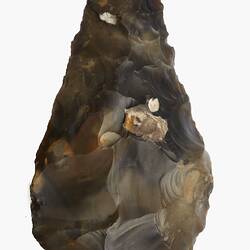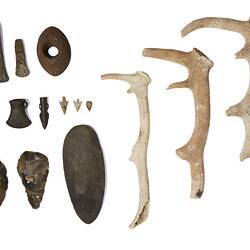Summary
Hundreds of thousands of years ago, a maker shaped this tool from flint. They were one of the hominins who inhabited what is today the United Kingdom, a figure among the kin folk of our human species who forged lives there in between the periods of fierce cold that hardened and chilled the landscape.
Hand axes such as these are seen as definitive of the period known as the Lower Palaeolithic. They are known as an 'Acheulean' type (a reference to the prominent hand-axe site of Saint-Acheul in Amiens, France). Such axes fit snuggly into the hand and are defined by flaking on both faces, a sharp edge, and the concentration of mass towards the rear of the tool. Archaeologists today posit that the hand axe was used as a butchery tool, with the skill of craftsmanship prompting some to speculate that such objects possibly also performed social functions such as attracting mates (Dale, 2022, pp. 19-33; 'Handaxes', Museum of Stone Tools).
In 1927, this hand axe was plucked from gravel deposits in Sabey's Pit in Yiewsley, west of London, during commercial gravel extraction. Antiquarian Robert Garraway Rice (1852-1933) added it to the collection of Paleolithic implements that he acquired in this area during the early decades of the twentieth century, possibly from labourers. Eastwood's Pit (later re-named 'Sabey's' after the new proprietors of the site) was the source of more than 1300 artefacts in Rice's collection (Collins, 1978, p. 23) and this abundance situates this place within a crucial landscape for the study of England's ancient past.
Rice died in early 1933 and his vast collection passed to the London Museum. Later that year, Dermot A Casey (1897-1977), Honorary Ethnologist with the National Museum of Victoria, spent several months in London negotiating exchanges of Australian collections with British colleagues. This hand axe was one of 79 objects that arrived as a result of Casey's approaches.
Bibliography
Luke Christopher Dale, 'Early Neanderthal social and behavioural complexity during the Purfleet Interglacial: handaxes in the latest Lower Palaeolithic', PhD Thesis, Durham University, 2022.
DJ Mulvaney, 'Obituaries: Dermot Casey', Australian Institute of Aboriginal Studies Newsletter, New Series No. 17, March 1982.
'Handaxes', Museum of Stone Tools website, https://stonetoolsmuseum.com/tool-type/handaxes/, accessed 9 October 2025.
Acknowledgements
With thanks to Professor Mark Moore of the Museum of Stone Tools, University of New England
Physical Description
A hand axe made of flint of a symmetrical shape.
More Information
-
Object/Medium
Axe
-
Locality
-
Date Produced
-
Date Collected
-
Object Measurements
180 mm (Length), 105 mm (Width), 40 mm (Height)
-
Keywords
-
Acquisition Information
Exchange from London Museum, Dermot A. Casey
-
Type of item
-
Discipline
-
Category
-
Collecting Areas
